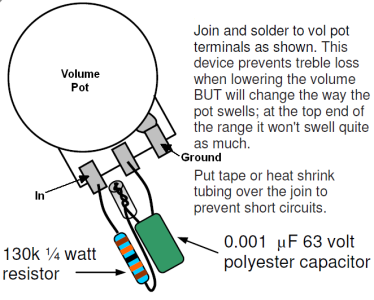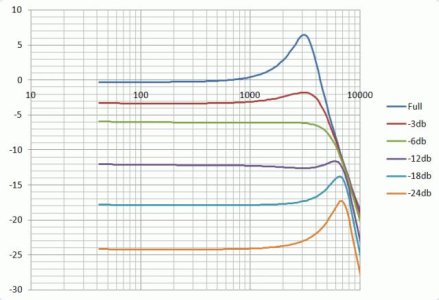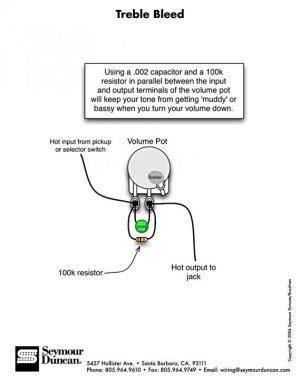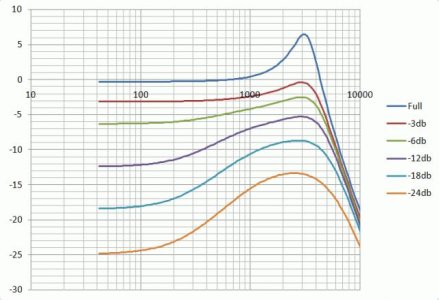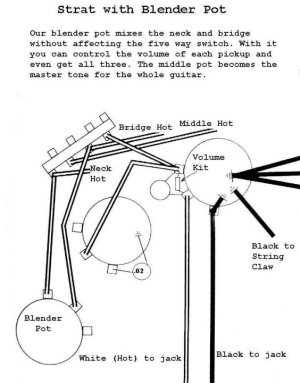DreX
New member
I've been trying different combinations of caps and resistors to get a better volume roll off behavior on my Strats, especially the ones with darker overwound pickups. I'm curious if anyone has come up with any combos and values they like more than others.
One thing I'm finding works good for me is combining the Kinman treble bleed, which has a resister and cap in series, and the more typical treble bleed with the cap and resister in parallel, so that you have the cap and resistor tied together which then lead into yet another resister. The function of the resister tied together in parallel with the cap is to let (mostly) balanced signal side step around the cap so that the bleed is not just strictly made up of high frequencies, and the purpose of the second resister that comes after the cap/resister pair is to reduce the influence of the pair in general so that as the volume is rolled down close to zero on the pot you, don't get an overabundance of the bleed tone.
One thing I discovered also is that jumping the "pickup in" and "output out" lugs on the volume pot can be good for more than just a treble bleed. Just putting a 150k ohm resister across the lugs makes the taper a little less logarithmic, and while that defies the concept of "audio taper", when you're using your "modern wired" volume with overdrive, it doesn't have a natural audio taper regardless, and what I find is that jumping the lugs with a resistor creates a broader usable range in the volume sweep and make the capacitor treble bleed less necessary. This is especially true as you roll off the volume to a point where the pot by itself would be attenuating highs that are being preserved by the jump resistor of lower value. It allows the overdrive to stay crunchier longer before becoming either anemic or tinny, almost as if you were working the gain dial on your amp.
There's a cool post on another forum where someone calculated the effect of various treble bleed mods http://guitarnuts2.proboards.com/thread/5317/treble-bleed-circuit?page=1 , it's very interesting and elucidated why I dislike the 50's mod. It's frequency profile is pretty bizarre compared to the various treble bleed mods, and you have the choice of either using your volume pot or your tone pot, but if you roll both at once you get higher frequencies, which is counter intuitive and harder to work with.
What I'm leaning towards now after messing with caps and resistors for an hour is a 640pF cap and 220k ohm resister in parallel, both in series with a 150k ohm resistor, all between the pickup and output volume pot lugs. The result is more subtle than other treble bleed mod values I've seen and it makes the top end of the volume sweep louder and richer than standard modern wiring.
Have you found any combos that you like?
One thing I'm finding works good for me is combining the Kinman treble bleed, which has a resister and cap in series, and the more typical treble bleed with the cap and resister in parallel, so that you have the cap and resistor tied together which then lead into yet another resister. The function of the resister tied together in parallel with the cap is to let (mostly) balanced signal side step around the cap so that the bleed is not just strictly made up of high frequencies, and the purpose of the second resister that comes after the cap/resister pair is to reduce the influence of the pair in general so that as the volume is rolled down close to zero on the pot you, don't get an overabundance of the bleed tone.
One thing I discovered also is that jumping the "pickup in" and "output out" lugs on the volume pot can be good for more than just a treble bleed. Just putting a 150k ohm resister across the lugs makes the taper a little less logarithmic, and while that defies the concept of "audio taper", when you're using your "modern wired" volume with overdrive, it doesn't have a natural audio taper regardless, and what I find is that jumping the lugs with a resistor creates a broader usable range in the volume sweep and make the capacitor treble bleed less necessary. This is especially true as you roll off the volume to a point where the pot by itself would be attenuating highs that are being preserved by the jump resistor of lower value. It allows the overdrive to stay crunchier longer before becoming either anemic or tinny, almost as if you were working the gain dial on your amp.
There's a cool post on another forum where someone calculated the effect of various treble bleed mods http://guitarnuts2.proboards.com/thread/5317/treble-bleed-circuit?page=1 , it's very interesting and elucidated why I dislike the 50's mod. It's frequency profile is pretty bizarre compared to the various treble bleed mods, and you have the choice of either using your volume pot or your tone pot, but if you roll both at once you get higher frequencies, which is counter intuitive and harder to work with.
What I'm leaning towards now after messing with caps and resistors for an hour is a 640pF cap and 220k ohm resister in parallel, both in series with a 150k ohm resistor, all between the pickup and output volume pot lugs. The result is more subtle than other treble bleed mod values I've seen and it makes the top end of the volume sweep louder and richer than standard modern wiring.
Have you found any combos that you like?

